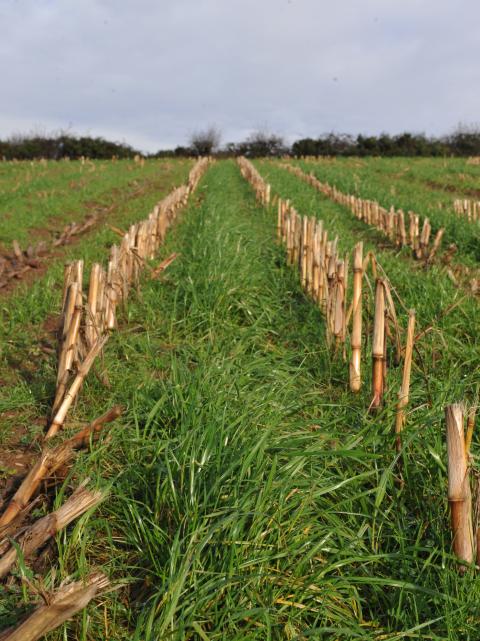9 December 2021
Under-sowing maize with grass is preventing winter soil erosion and nutrient loss at a Pembrokeshire livestock farm, and has the added benefit of winter grazing for tack sheep.
Mathew Van Dijk has hosted a Farming Connect trial, under-sowing five hectares (ha) of maize with four different seed mixes: Italian ryegrass, a straight tetraploid perennial ryegrass, an Italian ryegrass with winter vetch and an Italian ryegrass with berseem clover.
However, Mr Van Dijk was so impressed with the thinking behind this system that he didn’t limit under-sowing to the trial plots – he under-sowed his entire 28ha crop at Arnold’s Hill Farm, near Haverfordwest.
He believes it is important for farmers to be one step ahead, to act before regulation on protecting watercourses from phosphates forces them in that direction.
“As farmers, we need to understand more about our soils; if the soil isn’t right, the crop isn’t going to grow,’’ says Mr Van Dijk, who farms 121ha, where he runs a herd of 60 beef suckler cows and grows maize to sell to other farmers.
When fields are left bare, there is no root structure to hold onto the soil, but sowing a crop or cover after the harvest can be problematic, because of autumn soil condition and late sowing. Under-sowing provides a potential solution.
As many of Mr Van Dijk’s fields are sloping, there is a risk of soil losses and run-off when they are bare.
Agronomist Gareth Williams of Procam, the advisor on the Farming Connect project, said the sloping aspect of the trial field was a good one to test the value of under-sowing.
The grass cover crop was drilled at the beginning of July by Pembrokeshire contractor James George, who has invested in a drill suitable for this technique.
The target period for sowing a cover crop into maize is from one week after the last herbicide was applied, with maize plants at the six- or seven-leaf stage to prevent them being smothered by the grass.
The ley established well, and there was no negative impact on the maize yield - the crop of Augustus maize was harvested at the end of September and yielded around 43t/ha (17t/acre), similar to previous years.
The plots that provided the most cover were the Italian ryegrass and the Italian ryegrass and vetch mix, but Mr Williams said incorporating vetch delivered additional benefits, as it is nitrogen-fixing and high in protein.
As anticipated, the plot incorporating the berseem clover was negatively affected by the maize herbicide.
Mr Williams calculates that under-sowing costs around £35 an acre for the grass seed and cultivation work – but as well as generating a return from grazing, it also helps to retain nitrogen in the soil.
“It will retain 40 kg N/ha, which is good for the soil – but also financially important, when fertiliser is currently trading at around £650 a tonne,’’ he said.
Under-sowing helps at harvesting, too, as it provides a more stable surface for heavy machinery.
Mr Van Dijk will run 500 tack sheep on the under-sown grass this winter, and can expect to yield 2.5-3tDM/ha of feed from the ley - the equivalent of 1500 ewe grazing days a hectare.
In previous years, he would have sown grass after harvesting the maize, but it would not have been fit to graze until the beginning of March; by under-sowing, grazing can get underway as early as December.
Mr Williams anticipates that in the future, maize-growing in some regions might only be permitted if the grower can guarantee a crop being sown immediately after harvesting, or if the crop is under-sown.
“If farmers want to continue to grow maize and protect their soils and watercourses, they have to find a way of managing that,’’ he said.
Milk buyers are also encouraging their suppliers to adopt strategies that hold on to carbon.
The Farming Connect trial demonstrated that under-sowing is a viable option, said Mr Williams.
“In the last few weeks, some parts of Pembrokeshire have had four or five inches of rain; if the trial field had been left bare, there would have been run-off,’’ he said.
Dr Delana Davies, Knowledge Exchange Executive at Farming Connect, who is overseeing the trial, said under-sowing maize is increasingly being practised in the Welsh borders.
“The investment in a purpose-built drill by James George means that farmers in west Wales now have the opportunity to improve the environmental credentials of growing the crop,’’ she said.
For farmers who are considering under-sowing, seeking advice from an agronomist is an important first step. Mr Williams said the field must not have a high weed pressure; the field should be treated with glyphosate pre-cultivation to create a weed-free seed bed, and it is important to select the correct grass species for the job.
In Pembrokeshire, Dŵr Cymru Welsh Water has been working with Field Options and contractor James George, and subsidising maize under-sowing in its drinking-water catchments across Pembrokeshire.
Farming Connect is delivered by Menter a Busnes and Lantra Wales and funded by the Welsh Government and the European Agricultural Fund for Rural Development.

